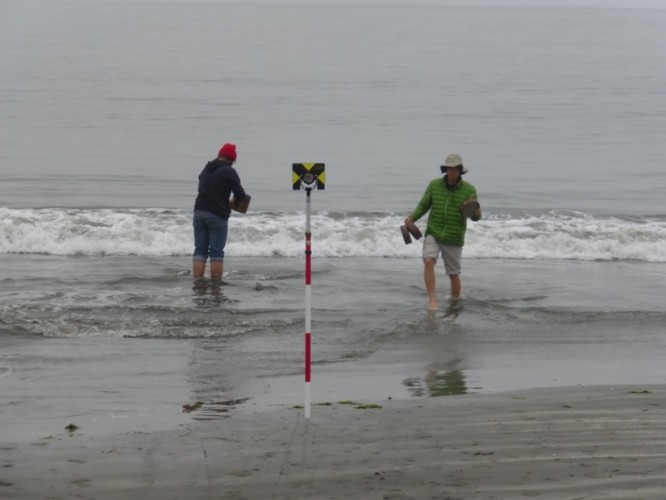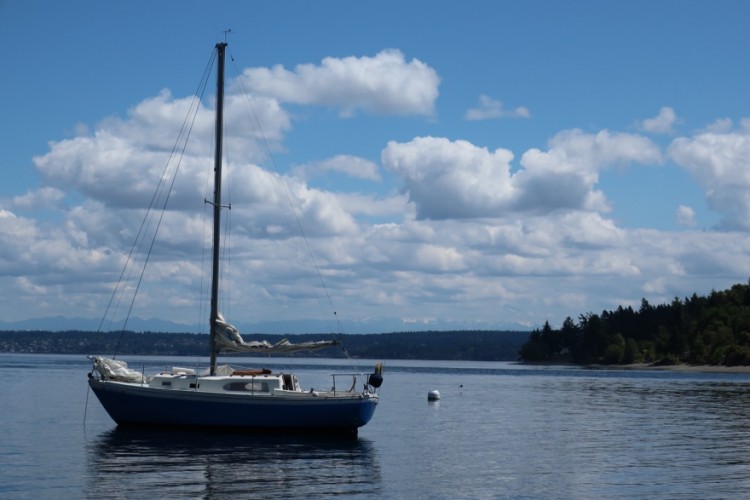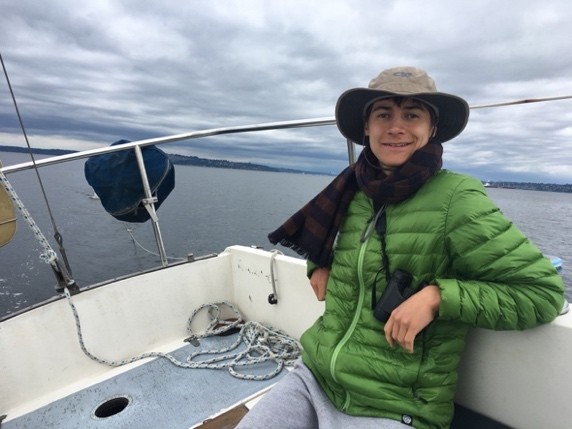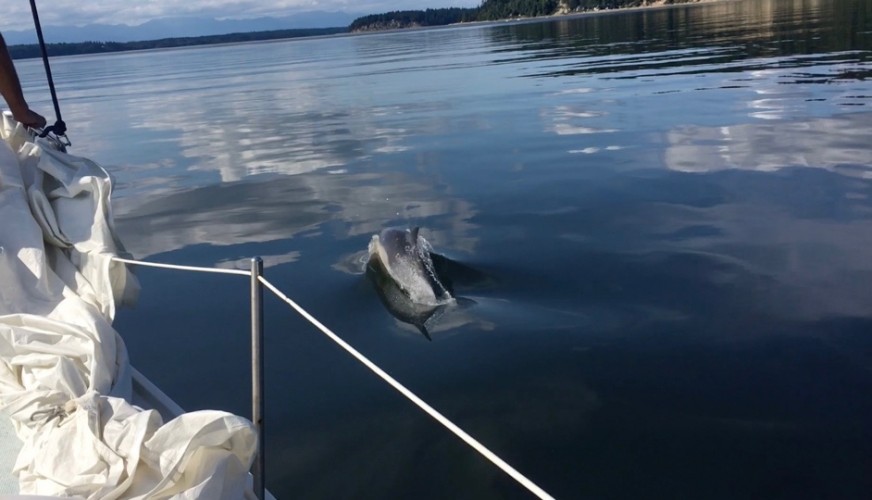Citizen Science from a Sailboat
by Michael P. Montgomery
Two and a half years ago, during winter quarter of my freshman year, I approached the professor of my Introduction to the Oceans class after lecture. “I like sailing,” I said. “Do oceanographic expeditions ever take place on sailboats rather than motorized ships? That would be something I would be interested in.” My professor’s answer was a gentle no; larger, engine-driven vessels are a must for the sorts of multidisciplinary cruises that define modern marine science, she said.
In hindsight, her answer makes perfect sense. Maybe it was stupid of me to ask. Nevertheless, I look back on that question now as a sign of burgeoning enthusiasm for the field that, a year later, I would declare as my major.
 I still ask plenty of questions of
my instructors. The more I learn, the more questions arise. But
there is no getting around the fact that despite my intent
interest in the science of the sea, I remain largely uninitiated
into its actual process. To the best of my abilities, I have
learned the theory of marine science inside and out: the physics
of upwelling, the chemistry of carbonate dissolution, the geology
of seafloor spreading (really just more physics), the ecology of
the intertidal. What I have not done, at least not enough to
boost my confidence in it, is apply that theory to the real
world. Sure, I took summer classes in 2018 at UC Davis’s Bodega
Marine Laboratory, where we measured beach slope and sand grain
size, studied phytoplankton under the microscope, and visited
shoreline boulders that had been rubbed by mammoths. I can’t
shake the feeling that none of this qualifies me as a real
scientist—at least, not yet.
I still ask plenty of questions of
my instructors. The more I learn, the more questions arise. But
there is no getting around the fact that despite my intent
interest in the science of the sea, I remain largely uninitiated
into its actual process. To the best of my abilities, I have
learned the theory of marine science inside and out: the physics
of upwelling, the chemistry of carbonate dissolution, the geology
of seafloor spreading (really just more physics), the ecology of
the intertidal. What I have not done, at least not enough to
boost my confidence in it, is apply that theory to the real
world. Sure, I took summer classes in 2018 at UC Davis’s Bodega
Marine Laboratory, where we measured beach slope and sand grain
size, studied phytoplankton under the microscope, and visited
shoreline boulders that had been rubbed by mammoths. I can’t
shake the feeling that none of this qualifies me as a real
scientist—at least, not yet.
Unlike many of my fellow students, I have not actively sought out laboratory work with professors. Feeling pulled in numerous academic directions at once, and making it a priority to explore each of them in some detail, I have been wary of throwing myself into projects that risk, or seem to risk, tedium. Part of this reluctance is legitimate. The rest stems from a weird mental block I seem to have developed against rote data collection and analysis.
One answer to this dilemma, I discovered last summer, is citizen science. Broadly defined as the participation in scientific inquiry of people who are not—or are not yet—professional scientists, citizen science has the remarkable capacity to be valuable, in different ways, to just about anyone. For scientists tackling otherwise intractable research questions, citizen science can marshal massive amounts of data at relatively little cost. For laypeople lacking classroom training, citizen science can provide an accessible introduction to scientific thinking and observation. And for students like me with no shortage of classroom training, citizen science can act as an affirming reminder that science does in fact take place outside of academia.
 In late July, I joined two longtime
friends of my father, now friends of mine, for a week of sailing
in the south Puget Sound. Our vessel was a 28-ft. Columbia
sailboat. (For comparison, the Bodega Marine Lab’s Research
Vessel Mussel Point is 42 feet long; the R/V Roger Revelle of the
Scripps Institute of Oceanography is 273 feet long.) When not
helping steer or rig sails, I spent much of the trip sitting
cross-legged on the bow, where I would read, watch passing
islands through my binoculars, and record observations in a
little notebook.
In late July, I joined two longtime
friends of my father, now friends of mine, for a week of sailing
in the south Puget Sound. Our vessel was a 28-ft. Columbia
sailboat. (For comparison, the Bodega Marine Lab’s Research
Vessel Mussel Point is 42 feet long; the R/V Roger Revelle of the
Scripps Institute of Oceanography is 273 feet long.) When not
helping steer or rig sails, I spent much of the trip sitting
cross-legged on the bow, where I would read, watch passing
islands through my binoculars, and record observations in a
little notebook.
 On the afternoon of Wednesday, July 24, something
spectacular happened. Three dolphins surfaced right next to our
hull. At the time, we had been motoring lazily north, with no
wind to be found, in a waterway called Case Inlet. Two of us were
sitting in the shade of the mainsail, our legs dangling over the
starboard railing; the other was lying on the deck in the sun.
The dolphins took us by surprise. Unlike the shy Dall’s porpoises
we’d encountered the day before, these cetaceans wanted to make
their presence known. Obviously curious, they swam alongside us
for several minutes, occasionally breaking the surface in unison
with their curved dorsal fins. Each time they did, rising from
depth, their white and grey markings appeared with startling
clarity.
On the afternoon of Wednesday, July 24, something
spectacular happened. Three dolphins surfaced right next to our
hull. At the time, we had been motoring lazily north, with no
wind to be found, in a waterway called Case Inlet. Two of us were
sitting in the shade of the mainsail, our legs dangling over the
starboard railing; the other was lying on the deck in the sun.
The dolphins took us by surprise. Unlike the shy Dall’s porpoises
we’d encountered the day before, these cetaceans wanted to make
their presence known. Obviously curious, they swam alongside us
for several minutes, occasionally breaking the surface in unison
with their curved dorsal fins. Each time they did, rising from
depth, their white and grey markings appeared with startling
clarity.
As abruptly as it had arrived, the pod moved on. One of the dolphins, following the others as they passed beneath and then beyond us from aft to fore, resurfaced a final time a foot from our bow and rolled in the wave created by our passage, as if in playful farewell.
Our excitement didn’t wear off for the rest of the afternoon. That three dolphins had chosen our sailboat to investigate felt too good to be true. When I began researching what kind of dolphins they had been, I started to suspect that the encounter was special for another reason, too. Everything I found online about morphology and coloration suggested that our visitors had been common dolphins, of the genus Delphinus. Meanwhile, everything I learned about common dolphins’ habitat and worldwide distribution—usually well offshore or in the tropics and subtropics—made their presence in the inner reaches of Puget Sound improbable. Mindful of misidentification, I kept searching for alternatives. Only after I had come across other confirmed sightings of common dolphins in that part of the Sound did I decide that the dolphins we saw had indeed been common dolphins.
The next step, of course, was to report the sighting to the proper scientific authority, which in this case turned out to be an organization called the Cascadia Research Collective. Conveniently, the page on their website that listed past rare dolphin sightings also included a phone number and email address for reporting recent ones. I called the number, left a message, and received a return call later that evening. Only after the sailing trip ended and I was back on land did I have the Internet bandwidth to email Cascadia my video of the encounter. One of the organization’s biologists responded and told me that my identification, at least to the level of genus, had been correct, even if differentiating between the long- and short-beaked species of common dolphin was not possible from my footage. Needless to say, I was excited.
Looking back on it, I see this series of events as nicely representing the pleasure and power of citizen science. It was a simple and personal process: making an observation, forming ideas, contributing data—or rather, the single datum of an unusual wildlife sighting. I felt proud to have correctly deduced the dolphins’ identity, especially outside their typical range, and proud to have added my observation to existing knowledge about Puget Sound. It was fun. What’s more, because sharing my observation required nothing more complicated than a phone call and brief email exchange, it relieved some of my apprehension about inexperience. I didn’t need to be a professional marine biologist to make a valuable contribution.
Science of this sort may not take place on the multimillion-dollar research vessels of the modern oceanographic fleet. It may not collect plankton tows, drill sediment cores, or run conductivity tests of seawater. It may not even publish its results. But maybe it doesn’t need to. Sailboat citizen science, as I would call it, serves its purpose best when serving its practitioners well: inspiring them to continue learning and participating; showing them that marine science is far less inscrutable and remote from their lives than they might have thought; and, at least for me, answering an answered but unresolved question: yes, oceanography can take place on a sailboat. In this as in citizen science more generally, no question is ever really answered until you answer it yourself.
Author: Michael is a fourth-year undergraduate at UC Davis. His major is Marine and Coastal Science – Oceans and the Earth System, and he plans to declare two minors: Professional Writing and History. Since 2018, he has been editor and lead author of the Monterey Audubon Society’s quarterly newsletter, The Sanderling. He joins the Center this fall as a writing intern.









